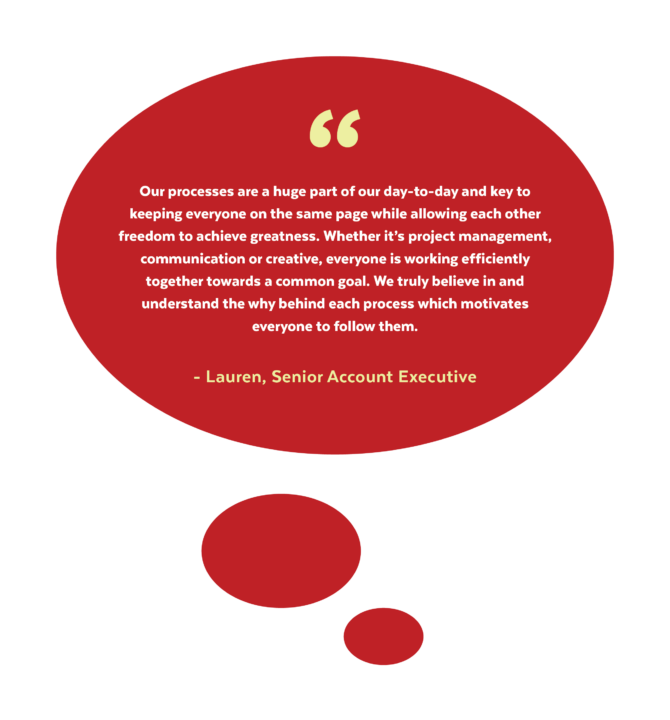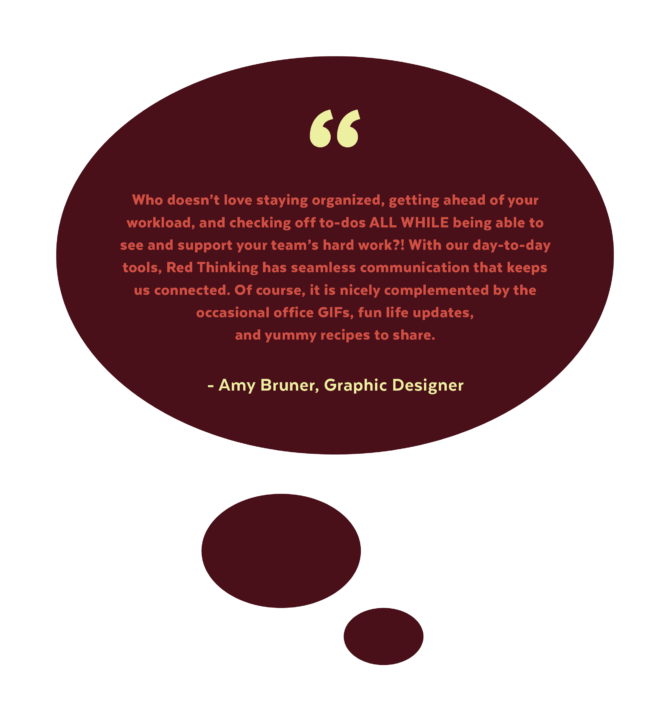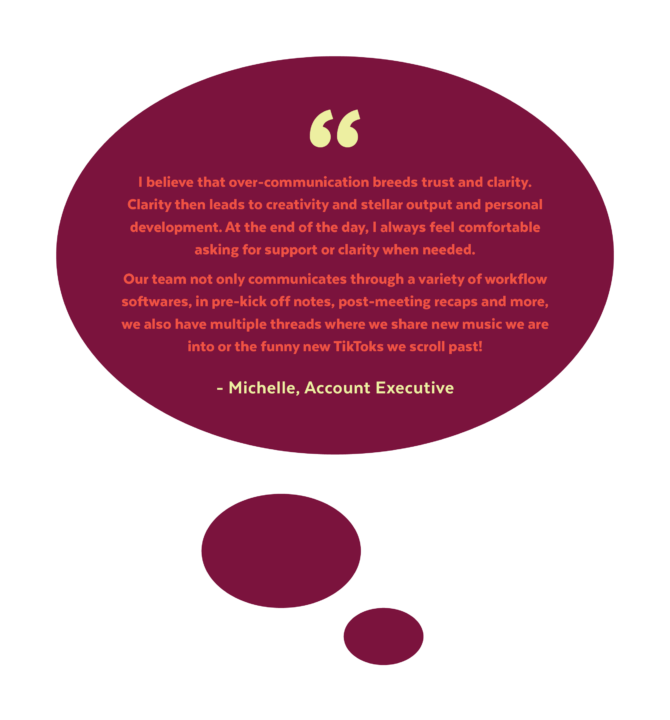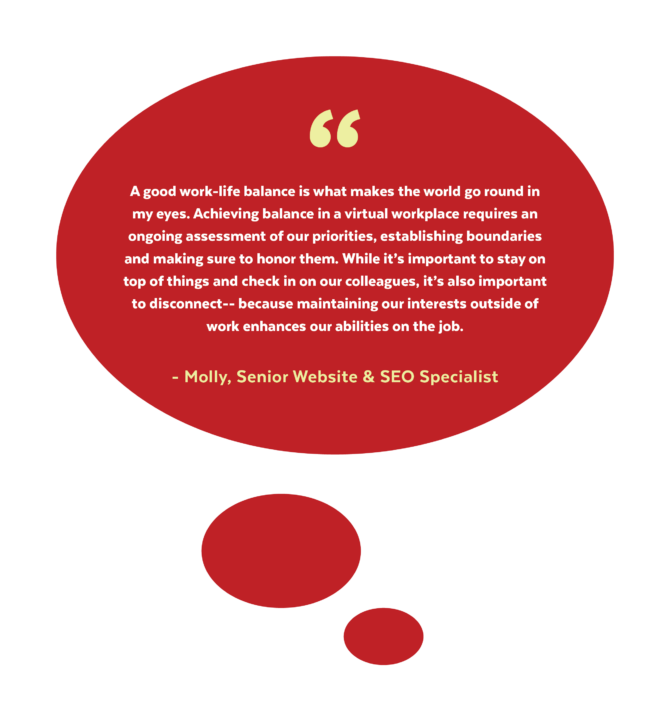While some companies are flirting with the idea of one or two days a week back in-office and others are enticing employees back to the office full-time with the promise of free lunch or fancy amenities, we’re staying home.
Because we found, years before 2020 happened, that work from home works for us.
I came from an agency where I’d worked for years to get the corner office — to achieve the success I thought was the goal. But I did that at the expense of personal and professional balance. I saw some of the best people we worked with leaving due to burn out and the exhaustion of working in cubes day-after-day.
I knew that just because something had been done one way for years didn’t mean it always had to be that way. The old way was broken, and I have always intended for Red Thinking to do something different, something better.
What mattered to me was what someone could do, not where they sat down to a computer, and I believed that those employees should work to live, not live to work. I give my best to my work when my day is balanced, allowing time for both focus and taking a break to walk outside on a beautiful day and pick up my daughter from the bus stop. Why shouldn’t I give the same opportunities to my employees?
In March 2020, Red Thinking had been fully remote for a decade. We were set up to succeed, and my phone started ringing. “How do you trust that the work will get done?” “What software do you use for communication?” “Is it possible to replicate water cooler chat?”
My answer was: Because I fully trust my team. I know I’m only as good as the incredible people I surround myself with, and we’ve built systems and processes that facilitate communication and camaraderie that is as good, if not better, than it ever was in person.
And here are 5 ways we do that. Here’s why WFH works for us.
We Tightened Up the Process First
At Red Thinking, we realized early on that time spent talking about processes is time that we’re not getting work done. With the entire team remote, we are in the fortunate position of prioritizing both efficiency and creativity. But, to do that, we put processes in place, tightened them up, and made sure that everyone was on board. Of course they’ll evolve as necessary, but that framework is critical to successfully working together, apart.

We Invest in the Right Remote Work Tools
Most of you are probably familiar with tools like Monday and Slack, and they are key players in our remote work stack. Investing in those tools makes everything from communication to cross-functional collaboration to project management, client relationships, and top notch customer service possible. Without investing in the right remote work tools, we’d be working with one hand tied behind our back.

We Focus on Team Dynamic and Relationships
Just because there’s not a standing Thursday team happy hour doesn’t mean there isn’t company culture. We work harder to focus on building positive team dynamics and deepening our work relationships. In a remote world, it can be easy to slide into transactional, get work done mode, but we make an effort to keep our people-first organization at the center of everything we do.
We prioritize relationship building so there is a foundation that goes beyond Zoom. We work better collaboratively when we know the humans behind the screen. We prioritize our time together through a full calendar of in-person events and activities, as well as making an effort to connect virtually.
When you get to know each other as people, you understand each person’s strengths and what gets them excited to get to work, giving you an opportunity to tap into those strengths each time a new challenge comes up.

We Over-communicate, Always
When we’re together, we prioritize time to do the big thinking. But, on a daily basis, we over-communicate about everything. You can’t assume someone learned something at the water cooler, you have to loop everyone into every conversation.
That over-communication of status updates and project management earns the team autonomy. It ensures there are the proper checks and balances in place and, in turn, gives everyone freedom to do their best work.

Walk the Balance Walk (Don’t Just Talk the Talk!)
The flexibility of a virtual workplace allows each team member to determine how — and where — they work best. But, as many companies found out in the past few years, it’s easy to say there’s balance. It’s not as easy to live it.
At Red Thinking, we are proud to be whole humans with interests and priorities inside and outside of work. Our passions outside of work make us better at work.
We know that the tools we just mentioned not only enable connection — they also can tempt constant connection. But we strive for balance, not checking Slack at all hours of the day and night.
We each have both a work family and a life family, and those families have boundaries. We set and respect those boundaries, and we realize those will change over time. The best way to find balance is to continuously check in on our priorities, make changes when necessary, and check in with our colleagues to see how they’re doing.

We’ll Continue to Make WFH Work For Us
With over a decade of working remotely successfully under our belt, we won’t be one of the companies going to the office in 2023. We’re confident WFH will continue to work for us, and that comes back to one overarching truth. I trust my team. I rely on them. And I know that when we hire the best people, we get the best work. That doesn’t matter where they live or where they choose to log in today or tomorrow. We’re in it together, apart.


